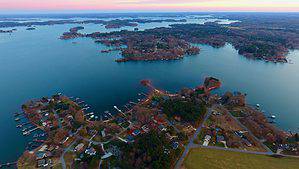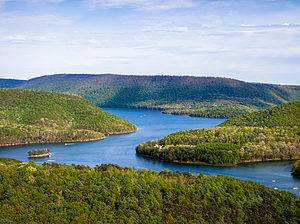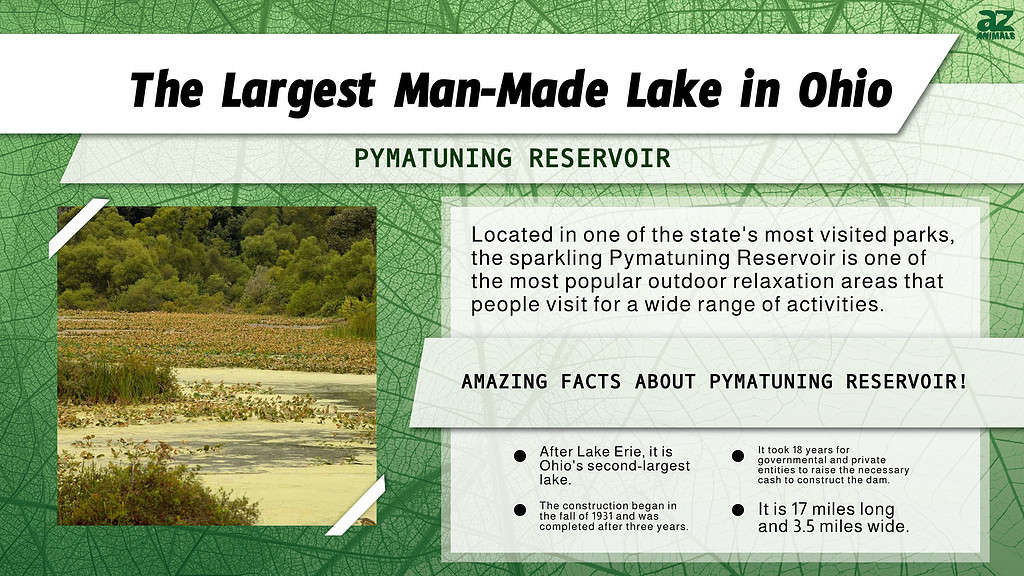
The State of Ohio borders Lake Erie, one of America’s Great Lakes. But that’s just one of several massive water bodies in the state. Ohio has natural and artificial lakes where people can go fishing, boating, or camping. While Lake Erie is the largest natural lake in Ohio, the largest man-made reservoir in the state is Lake Pymatuning. Located in one of the state’s most visited parks, the sparkling Pymatuning Reservoir is one of the most popular outdoor relaxation areas that people visit for a wide range of activities. This post details all you need to know about the massive Pymatuning Reservoir, including its size, location, wildlife, and other exciting details.
Location and Size of the Largest Man-Made Lake in Ohio
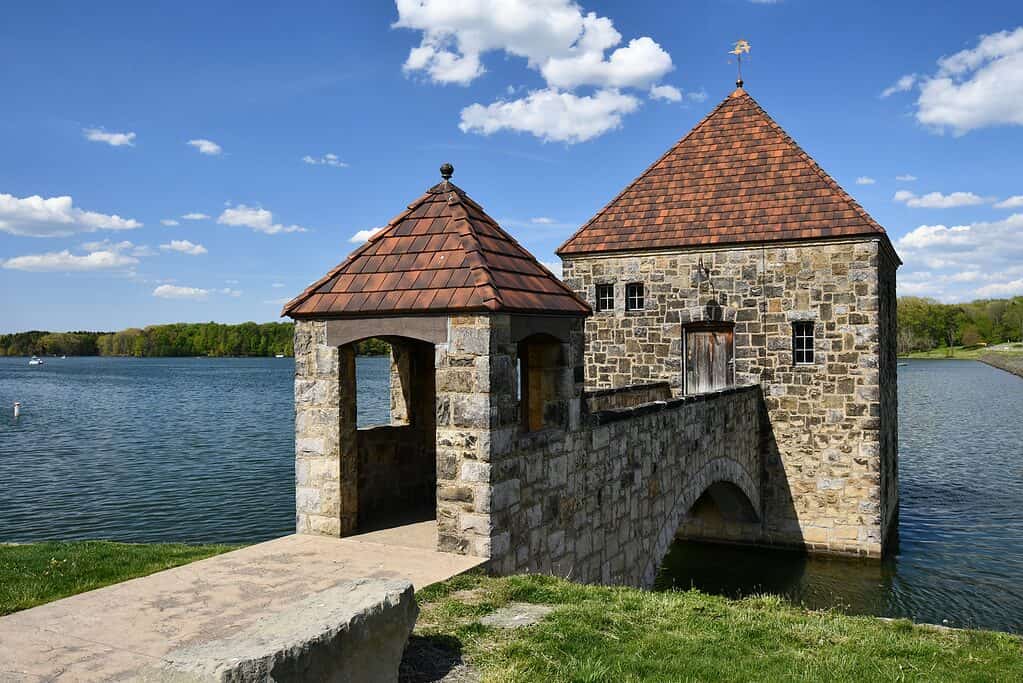
Spanning western Pennsylvania and northeastern Ohio, the Pymatuning Reservoir is about 17 miles long.
©Wirestock Creators/Shutterstock.com
The Pymatuning Reservoir, which spans western Pennsylvania and northeastern Ohio, has an area of 17,088 acres. The massive man-made reservoir is about 17 miles long and 3.5 miles wide. With more than 70 miles of shoreline, this lake has a maximum depth of 35 feet and stores about 67.3 million gallons of water. Aside from Lake Erie, it is Ohio’s largest lake.
Due to the size of the Pymatuning Reservoir and its location straddling two states, there are two Pymatuning State Parks. There’s one in Pennsylvania and another in Ohio. The Pennsylvania park is bigger, covering a land area of 21,122 acres, while the Ohio park only covers 3,512 acres.
The Pennsylvania Fish and Boat Commission, which administers various public recreation facilities around the lake, owns and manages some of the lands. The remaining area is privately held and is being developed for residential and commercial purposes.
The International Union for Conservation of Nature and Natural Resources (IUCN) has designated the Pymatuning Reservoir as a monument or landmark to ensure the preservation, conservation, and restoration of specific species and ecosystems in and around the lake.
History of the Pymatuning Reservoir
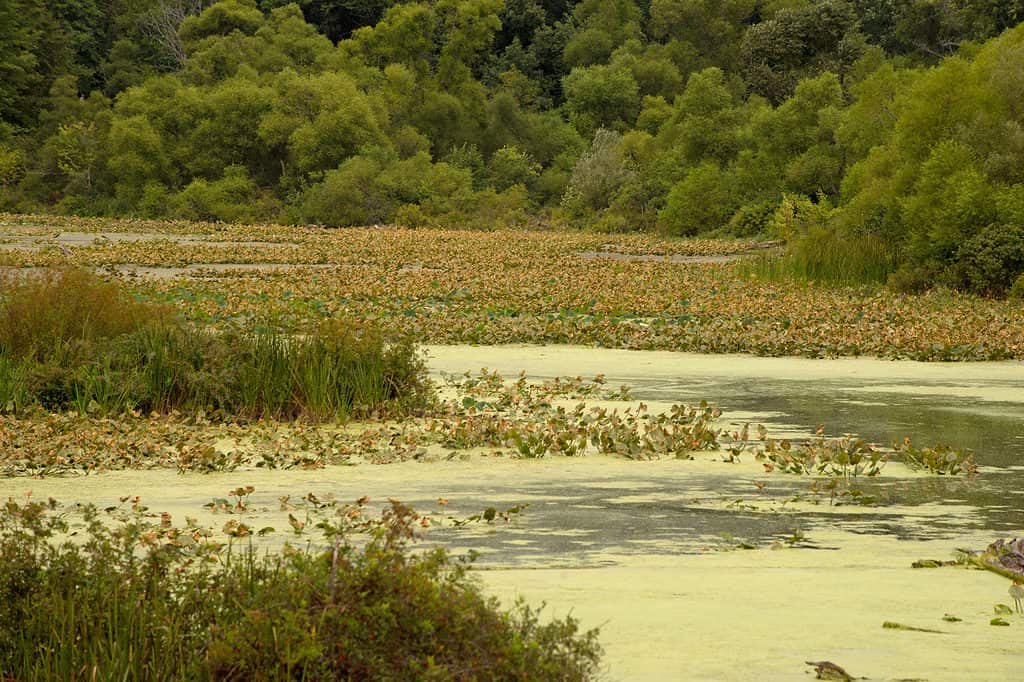
The Pymatuning Reservoir used to be the Great Pymatuning Swamp, a wetlands area.
©Patrick baehl de Lescure/Shutterstock.com
During the last ice age, glaciers melted in the area where the Pymatuning Reservoir is now located, filling it with sediments and forming wetlands around the Shenango River’s basin. Roughly 3000 years ago, The Pymatuning Reservoir, which used to be the Great Pymatuning Swamp, was a wetland inhabited by the mound builders — an ancient group of people known for their mound earthworks.
In 1868, plans were developed to drain the swamp and convert the area into farmlands. However, the idea did not go through because it would cripple the businesses downstream in the Beaver and Shenango Valleys. Logging activities around the swamp in subsequent years harmed the wetland’s potential for water management.
Due to deforestation, soil washed into the different channels and streams, blocking the regular water flow into the Shenango River. The irregular water flow worsened both spring floods and summer droughts, leading to the devastating flood of 1913. Floodwaters destroyed over 60,000 structures and drowned 115 people in Eastern Ohio and Northwestern Pennsylvania. The 1913 flood prompted the legislature to pass The Pymatuning Act, which established a reservoir to prevent future flooding.
Damming the Swamp
The Pennsylvania General Assembly approved a $1.2 million budget for a dam across the Shenango River, but Governor John K. Tener reduced it to $100,000. In 1917, the legislature acted once more. This time, a $400,000 budget was approved on the condition that the required land in Ohio be purchased by the private sector. It took 18 years for governmental and private entities to raise the necessary cash to construct the dam.
The construction began in the fall of 1931 and was completed after three years with nearly 7,000 men working on the project. The Civilian Conservation Corps constructed structures and paved roads to transform the land surrounding the reservoir into one of Pennsylvania’s largest state parks. The reservoir served its original goal by preventing future floods and droughts.
Animals in the Largest Man-Made Lake in Ohio
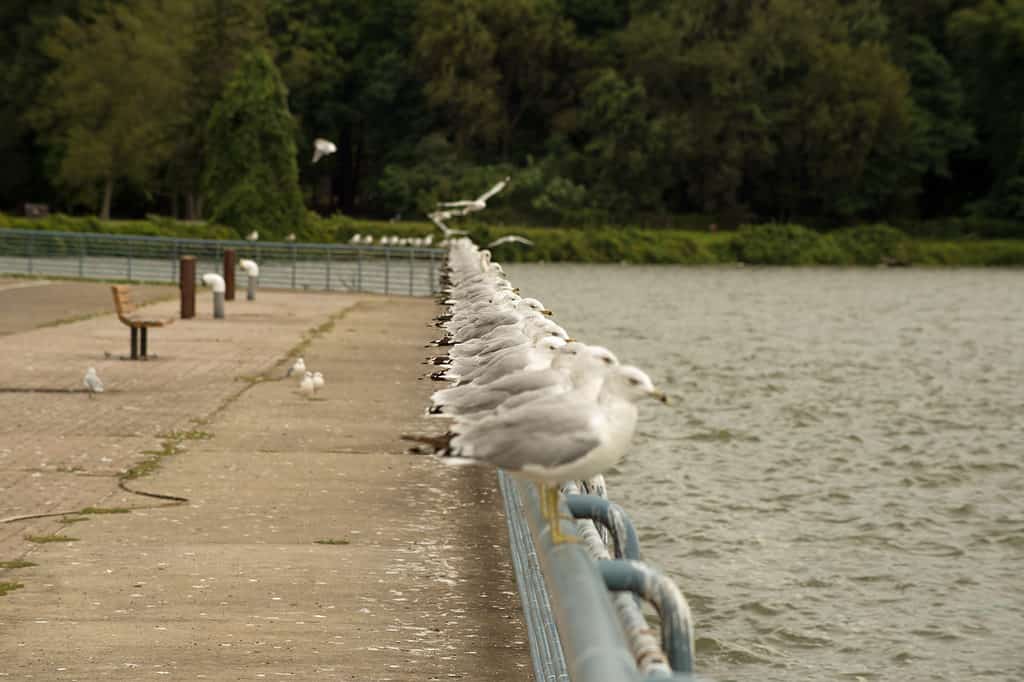
Seagulls like to hang around at Pymatuning Reservoir.
©Patrick baehl de Lescure/Shutterstock.com
Since the Pymatuning Reservoir’s waters tend to run warm, the reservoir is frequently supplied with a wide variety of warm water species. To fish in the reservoir, one must have a fishing license from either state unless you’re fishing from a boat. Only Ohio-licensed fishermen can fish from the Ohio shore, and Pennsylvania-licensed fishermen can fish from the Pennsylvania side.
Walleye and black crappies are popular species in the Pymatuning Reservoir, and they can frequently be found in locations with submerged cover. Muskellunge, or muskies, can be found in the Pymatuning Reservoir because they thrive in slow-moving water. Common carp, largemouth bass, smallmouth bass, channel catfish, bluegill, carp, and perch are some of the other fish species found in this lake.
The plains surrounding Pymatuning are rich in habitat for geese and ducks. The ecological communities in the Pymatuning Creek watershed are exceptional. Populations of 71 uncommon species, including 26 endangered species, have been documented in the watershed.
Tourism and Recreation in the Largest Man-Made Lake in Ohio
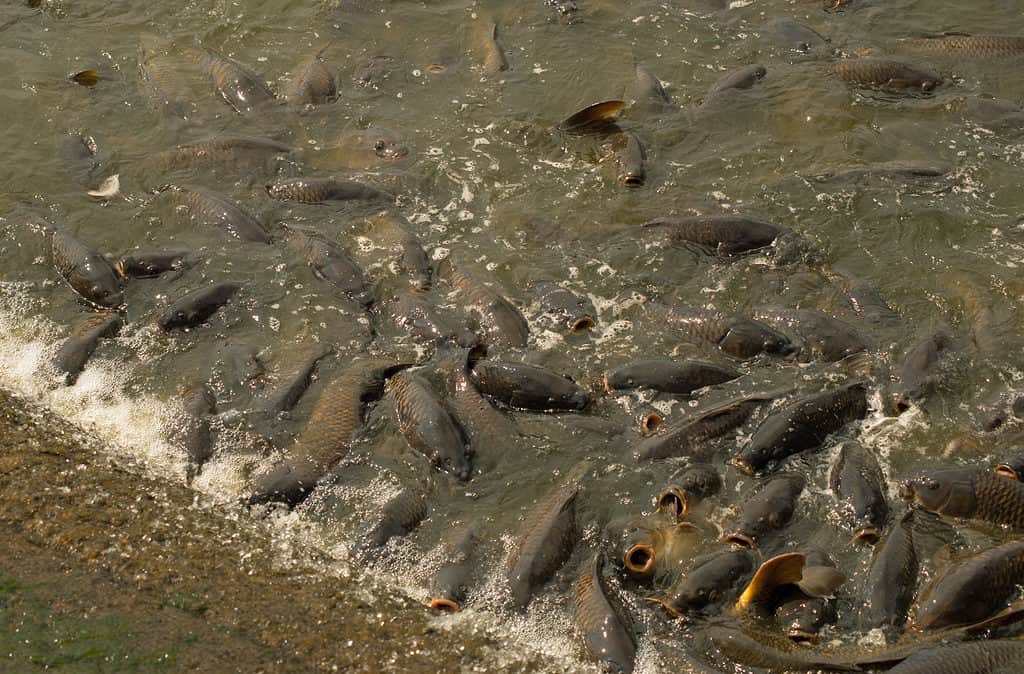
Fishing is a popular activity for visitors of Pymatuning Reservoir.
©Patrick baehl de Lescure/Shutterstock.com
Pymatuning Park, where Pymatuning Lake is located, is one of the most frequented tourist attractions in the state. The park receives almost 2.5 million people each year, more than any other park in the state. Pymatuning Lake is open all year and is well-known for its four-season amenities.
Another popular Pymatuning leisure activity is fishing — the Pennsylvania State Park’s Fish and Boat Commission operates one of the world’s largest warm-water hatcheries. Linesville Spillway, where “the ducks walk on the fish,” is one of Pymatuning Lake’s most unusual sights. Every year, an estimated 300,000 visitors go to the lake to feed the carp and ducks each week. In their frenzy, the carp scramble to catch as many morsels as possible and are so dense in the water that ducks competing for the bread can walk the lake on the backs of the fish.
Threats to the Pymatuning Reservoir
The Pymatuning Reservoir is a beautiful destination that is teeming with life. However, this does not mean that the lake is without threats. The Pymatuning Reservoir has a number of potential threats, including;
- Invasive species: Pymatuning Lake is home to several invasive species, including Eurasian watermilfoil and zebra mussels, which can outcompete native species for resources and alter the ecosystem.
- Water quality: Pollution and runoff from agricultural and urban areas can threaten the water quality of the reservoir, affecting the health of the fish, ducks, and other organisms in the water.
- Climate change: Rising temperatures and changing precipitation patterns associated with climate change are posing a threat to the largest man-made lake in Ohio.
- Human activity: Visitors are known to fish and participate in boating and other recreational activities in the lake. The impact can potentially harm the ecosystem and other wildlife. Continued infrastructural development in the area can also disrupt the habitat of some species at the reservoir.
Where Is the Pymatuning Reservoir on a Map?
The largest lake in Ohio, Pymatuning Reservoir, straddles the Ohio/Pennsylvania border with the majority of the lake on the Ohio side. It is situated between the towns of Linesville to the north and Jamestown to the south.
Conclusion
The Pymatuning Lake is not just the largest man-made lake in Ohio or a mere recreational center for visitors. It is also an important part of the region’s cultural resources. It contributes to the local tourism business and the economy in general. The Ohio government and International bodies are making various efforts to manage and conserve the lake and surrounding parkland for the present and future generations of Ohio and the United States.
The photo featured at the top of this post is © Wirestock Creators/Shutterstock.com
Sources
- The Historical Marker Database, Available here: https://www.hmdb.org/m.asp?m=107661
- Pennsylvania Department of Conservation & Natural Resources, Available here: https://www.dcnr.pa.gov/StateParks/FindAPark/PymatuningStatePark/Pages/default.aspx
- Wikipedia, Available here: https://en.wikipedia.org/wiki/Pymatuning_Reservoir
Thank you for reading! Have some feedback for us? Contact the AZ Animals editorial team.




